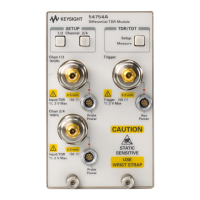Single-ended TDR Measurements
Single-ended TDR Features
7-7
In cases where a discontinuity is due to a lumped L or C, the Excess L/C can be
used to directly measure the L or C value. This is done by placing one marker
just to the left of the discontinuity and the other marker just to the right of the
disconinuity. The oscilloscope will calculate the excess L/C by integrating the
% reflection between the markers.
When measuring discontinuities on lines whose impedance is not 50 ohms, the
Excess L/C measurement is still valid as long as the 50 ohm measurement system
is connected the non-50 ohm line without using matching resistors.
It is also possible measure the Excess L/C of shunt inductors and series
capacitors using TDT measurements. A TDT measurement of a 50 ohm system
with a shunt inductance produces a negative bump in the transmitted response
while a series capacitance produces a positive bump in the transmitted
response.
Alternate Channel Scales
Many times when making TDR measurements, you may want to view a TDR
waveform in units of % reflection or ohms as the vertical scale. This can be done
using the
Alternate Scale . . .
control in the SETUP Channel menu. You must
establish normalization and reference plane values before you can select either
of these two scales.
When making TDT measurements, channels may be viewed in units of gain,
volts, watts, amperes, and unknown.
The reference plane calibrations as well as normalization calibrations are
volatile and are lost when power is cycled.

